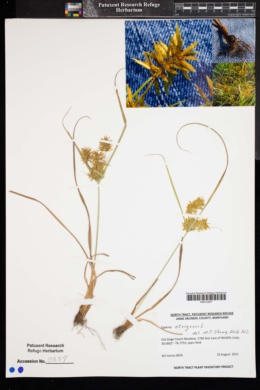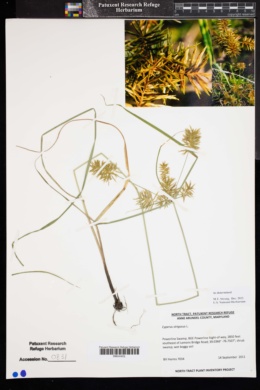Cyperus strigosus
|
|
|
|
Family: Cyperaceae
Straw-Color Flat Sedge, more...strawcolored flatsedge, stawcolored flatsedge, strawcolor flatsedge, strawcolor nutgrass, strawcolored nutgrass
[Cyperus hansenii Britt., moreCyperus michauxianus var. elongatus , Cyperus naguensis Britton, Cyperus stenolepis Torr., Cyperus strigosus var. capitatus Boeckl., Cyperus strigosus var. compositus , Cyperus strigosus var. elongatus (Torr.) Britton, Cyperus strigosus var. multiflorus Geise, Cyperus strigosus var. robustior Britt., Cyperus strigosus var. stenolepis (Torr.) Kükenth.] |
Herbs, perennial (often flowering first year), rhizomatous. Culms basally swollen and cormlike, trigonous, (1-)20-40(-90) cm × 1-6 mm, glabrous or few prickles subapically. Leaves flat, (10-)20-40 cm × 1-4(-8) mm, margins and midribs glabrous or scabridulous. Inflorescences: spikes 1-4, loosely ovoid to oblong-cylindric; (6-)10-28(-50) × 10-40 mm; rays sometimes absent, usually (1-)3-6(-8), 0.5-7(-25) cm; if absent, inflorescence a congested head; 2d order rays sometimes present, 1-4(-9) cm; rachis 8-18(-25) mm; bracts (3-)5-7(-10), ascending at 30-45°, cross ribs sometimes conspicuous, (1-)10-30(-45) cm × (1-)2-4(-12) mm; rachilla ± deciduous, wings 0.4-0.5 mm wide. Spikelets (5-)12-50, linear-lanceoloid, compressed, 5-30 × 0.6-0.9 mm; floral scales ± deciduous, 3-11, appressed, medially green, laterally stramineous to pale brown, 3-4-ribbed laterally, (1-)3-ribbed medially, oblong-obovate, 3.2-4.5(-6) × 1-1.8 mm, apex ± acute, overlapping lower 1/4-1/2 of next scale. Flowers: anthers 0.3-0.5 mm; styles 1-2 mm; stigmas 3-4 mm. Achenes purplish brown, ± stipitate, narrowly oblong, (1.5-)1.8-2.4 × 0.5-0.6 mm, apex apiculate, acute, surfaces puncticulate. Fruiting summer. Pond shores, ditches, damp, disturbed soils, sometimes weeds of gardens or croplands; 0-1500 m; Man., Ont., Que., Sask.; Ala., Ariz., Ark., Calif., Colo., Conn., Del., D.C., Fla., Ga., Idaho, Ill., Ind., Iowa, Kans., Ky., La., Maine, Md., Mass., Mich., Minn., Miss., Mo., Nebr., Nev., N.H., N.J., N.Mex., N.Y., N.C., Ohio, Okla., Oreg., Pa., R.I., S.C., S.Dak., Tenn., Tex., Utah, Vt., Va., Wash., W.Va., Wis. Cyperus strigosus is usually among the more common Cyperus species throughout its range. Small individuals flowering the first year may be difficult to distinguish from C. polystachyos, C. odoratus, C. erythrorhizos, and C. esculentus, which may be sympatric. Cyperus strigosus has trigonous achenes and three stigmas, unlike C. polystachyos; C. strigosus has flattened spikelets, unlike the subcylindric ones of C. odoratus; C. strigosus has floral scales usually 3 mm or more, unlike the smaller (1.2-1.5 mm) ones of C. erythrorhizos; C. strigosus has deciduous floral scales and a cormlike stem base with stolons, unlike C. esculentus. Cyperus strigosus appears to be closely related to the neotropical C. camphoratus Liebmann; both species have deciduous floral scales and deciduous spikelets (G. C. Tucker 1994). Plants segregated as C. stenolepis cannot be distinguished consistently from C. strigosus on any single charcter, rather they appear to be merely large individuals of C. strigosus with long floral scales and frequently septate inflorescence bracts (M. L. Horvat 1941).
Perennial herb with rhizomes 10 cm - 0.6 m tall Leaves: basal, alternate, 20 - 40 cm long, 1 - 10 mm wide, flat, linear, parallel-veined, keeled beneath, with a sheathing base that encloses the stem. Inflorescence: consisting of one to four terminal spikes, subtended by spirally arranged leafy bracts. Bracts five to seven, ascending, unequal, 10 - 30 cm long, 2 - 4 mm wide. Rays (branches of inflorescence) three to six, sometimes absent, sometimes branched above, 0.5 - 7 cm long (upper ones, if present, 1 - 4 cm long). Spikes 1 - 2.8 cm long, 1 - 4 cm wide, loosely egg-shaped to narrowly cylindrical, consisting of twelve to fifty spikelets. Flowers: minute, in the axil of a floral scale, lacking sepals and petals. Stamens exserted. Anthers to 0.5 mm long. Pistil one. Style 1 - 2 mm long. Stigma 3 - 4 mm long. Fruit: a one-seeded achene, held between the wings of the spikelet axis, more or less short-stalked, purplish brown, 1.5 - 2.5 mm long, about 0.5 mm wide, narrowly oblong with a pointed apex bearing a short, slender point, three-angled, tiny-dotted. Seed with a thin, non-adherent wall. Culm: one or few, 10 cm - 0.6 m long, 1 - 6 mm wide, triangular in cross-section, swollen basally, solid. Spikelets: 0.5 - 3 cm long, 1 - 2 mm wide, compressed, narrowly lance-shaped, subtended by two small bracts, with three to eleven floral scales. Scales appressed, green down the middle, straw-colored to brown along the sides, 3 - 4.5 mm long, 1 - 1.5 mm wide, oblong reverse egg-shaped with a more or less pointed apex, three-ribbed (down the middle), three- to four-ribbed (along the sides), keeled, lowest one empty. Similar species: No information at this time. Flowering: late July to early September Habitat and ecology: Common in the moist soil of marshy areas and cultivated ground. Occurence in the Chicago region: native Etymology: Cyperus is the ancient Greek word for sedge. Strigosus means "with bristles." Author: The Morton Arboretum Short-lived perennial without well developed rhizomes, sometimes blooming the first year; stems few or solitary, smooth, sharply triangular, 1-6(-10) dm; lvs crowded toward the base, mostly 2-10(-15) mm wide; spikes usually branched at base; spikelets numerous in short-cylindric spikes, spreading ±at right angles from the ±elongate rachis, 6-25 נ1-2 mm, strongly compressed, deciduous at maturity, the rachilla disarticulating just above the reduced lowermost pair of scales; scales (3-)3.5-4.5(-5) mm, keeled and multinerved, with greenish midrib and ±golden sides, tending to be narrowly hyaline-margined distally, persistent, each one overlapping the next one above on the same side; anthers less than 0.5 mm; achene 1.5-2 mm, unequally linear-trigonous, held between the hyaline wings of the readily deciduous rachilla. Moist fields, swamps, and shores; Que. to Minn. and S.D., s. to Fla. and Tex., and w. irregularly to the Pacific Gleason, Henry A. & Cronquist, Arthur J. 1991. Manual of vascular plants of northeastern United States and adjacent Canada. lxxv + 910 pp. ©The New York Botanical Garden. All rights reserved. Used by permission. From Flora of Indiana (1940) by Charles C. Deam This species is, without doubt, found in every county in the state. The extreme variability of this species has led authors to assign botanical names to the variations. I agree with some other authors in thinking that the forms are a matter of nutrition or of habitat and have no taxonomic value; hence I am referring all forms to the species. It is found in moist soil of almost all kinds and in all kinds of habitats. Probably most abundant along ditches and in cornfields. |
|
|
|




































































































